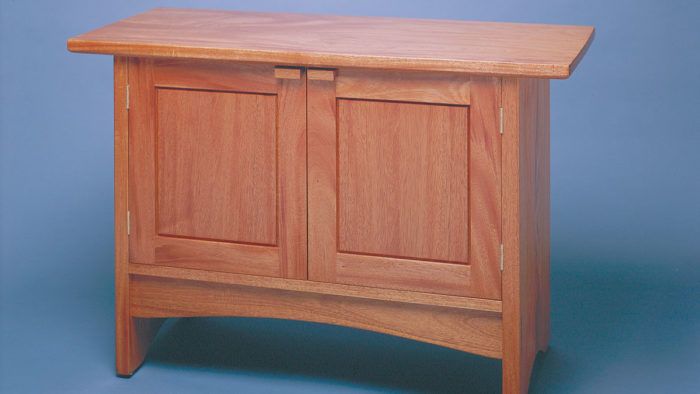
Synopsis: The two-door credenza John McAlevey designed doesn’t have dovetails on the corners. Instead, he used production-oriented dowels and plate joints to save time while maintaining the structural integrity of the piece. He used through mortises in the sides of the carcase and doweled the sides. Through mortises and wedged tenons anchor the bottom stretchers, and plate joints hold the bottom panels to the sides. Cabinetmaker’s buttons fasten the bottom panel to the stretchers. A detailed project plan clarifies the joinery, and side information covers laying out curves.
Most of my furniture designs begin as simple sketches. I draw on a regular basis, sometimes entire pieces, other times just certain curves or details. When finished, I date the drawings and stack them with drawings from previous sessions. Then, when I need ideas, I rip through the stack.
The two-door credenza shown here began that way. I was asked to build the credenza as a companion piece to a South American mahogany conference table I had made for a law firm’s library. When I dug out my first drawings of the table, the rough sketches showed how I had experimented with slight curves, plain round edges and large overhangs as I designed. I knew the credenza would need similar curves and an overhanging top for it to relate visually to the table.
I like to plan all my joinery and construction details before I even touch the wood. After rough-sketching the credenza, for example, I made a complete set of working drawings, including joinery details. Since this credenza has a top that overhangs the sides, I couldn’t use dovetails, my usual method for casework, to join the corners. I knew I could have added an applied top to overhang the dovetailed case, but this seemed a waste of wood. Stub tenons would have worked, but they seemed a waste of time.
So, I began to rethink my ideas on joinery. Why not mix traditional joints, like dovetails and mortises and tenons, with production-oriented joints, like dowels or plate joints? These joinery combinations would save time while maintaining the structural integrity of the piece. For example, I planned to dowel the top to the case, and to have a frame-and-panel back. The back would sit in rabbets in the sides of the case, but I did not wish to rabbet it into the top for two reasons. First, I thought it would put unnecessary racking strain on the dowel joints, and second, I wanted to overlap the top at the back a little bit, and thought that a rabbet here would look unattractive. The solution was a dovetailed back stretcher to which I could screw the back. Through mortises and wedged tenons could fasten the bottom stretchers to the sides, as well as add a nice design feature. I could simply plate-join the bottom panel to the sides to keep this joint tight, and then use cabinetmaker’s buttons, as shown in the detail on the facing page, to fasten the bottom panel to the stretchers.
Since the conference table was made of South American mahogany, I used mahogany to build the credenza. I like the wood’s grain and color.
From Fine Woodworking #71
For the full article, download the PDF below:
Fine Woodworking Recommended Products

Drafting Tools

Drafting Tools

Compass






















Log in or create an account to post a comment.
Sign up Log in